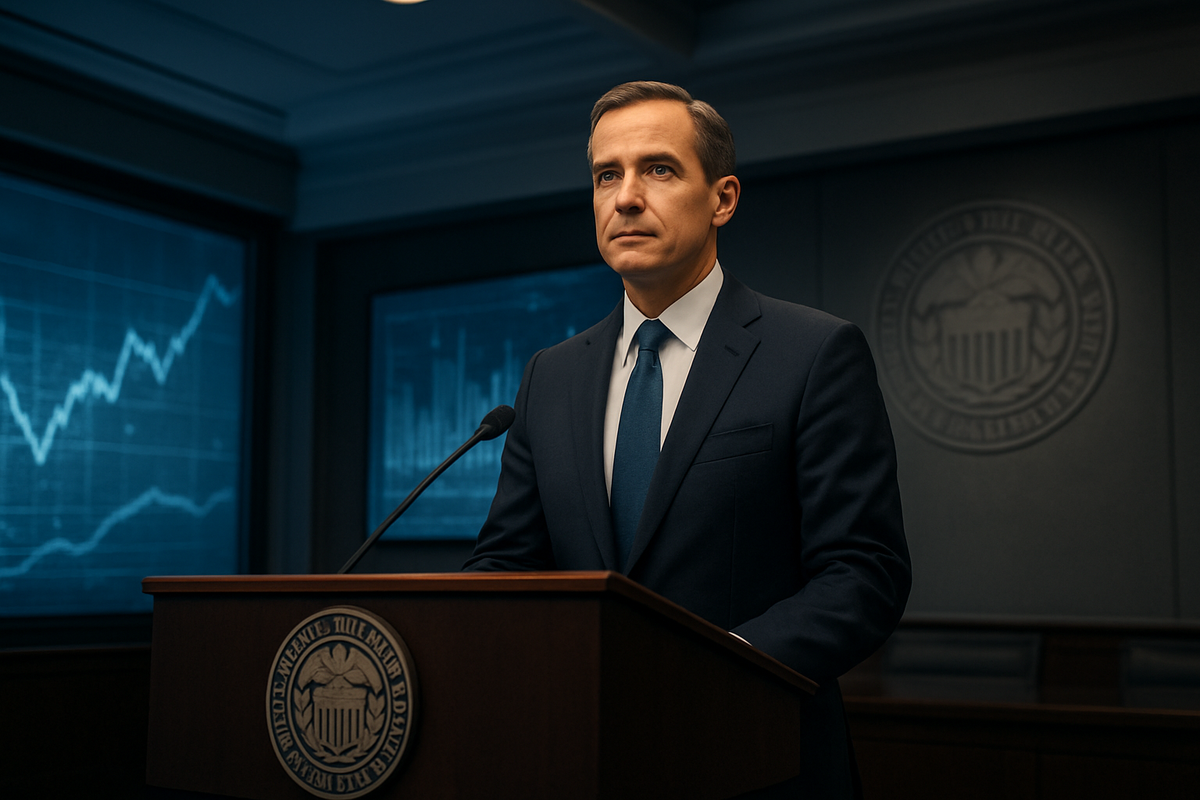
Federal Reserve Governor Stephen Miran, a recent appointee with strong ties to former President Donald Trump, is advocating for a significant 50 basis point (bps) interest rate cut at the Federal Reserve's upcoming December 2025 meeting. This bold call diverges sharply from current market expectations, which largely anticipate a more modest 25 bps reduction, or even a hold. Miran's stance, aligning with Trump's long-held desire for lower interest rates, introduces a new layer of uncertainty and potential volatility into financial markets as investors weigh the possibility of a more aggressive monetary policy shift.
His persistent push for deeper cuts, building on previous dissents in September and October, signals a potential internal struggle within the Federal Reserve. Should Miran's view gain traction, it could accelerate economic stimulus, impacting everything from borrowing costs for consumers and businesses to the valuations of public companies across various sectors. The market is now keenly watching how this influential voice, backed by a former president, will shape the Fed's crucial year-end decision.
Miran's Aggressive Stance Rattles Fed Consensus
Federal Reserve Governor Stephen Miran, who officially joined the Board of Governors on September 16, 2025, with significant endorsement from President Donald Trump, has quickly established himself as a vocal proponent for more substantial interest rate reductions. Miran's call for a 50 bps cut in December is not an isolated incident; it follows his dissenting votes in both the September and October 2025 Federal Open Market Committee (FOMC) meetings, where he argued for larger cuts than the 25 bps increments approved by the majority.
Miran's rationale centers on his belief that the U.S. economy requires more immediate and forceful relief to prevent a potential slowdown. He views the Federal Reserve's current monetary policy as overly restrictive, asserting that the "neutral" interest rate (r-star) is considerably lower than what many of his colleagues estimate. Furthermore, Miran points to the surging demand for stablecoins as a factor contributing to a structural depression in borrowing costs. He argues that the projected significant growth of dollar-pegged tokens increases demand for U.S. Treasury bills and liquid dollar assets, thereby exerting downward pressure on the neutral interest rate and necessitating lower policy rates. While acknowledging that a 25 bps cut would be a "bare minimum," he maintains that a 50 bps reduction is the appropriate measure given his economic outlook.
The timeline of events highlights Miran's rapid impact on Fed discourse. His appointment in September, followed by immediate dissents, set the stage for this latest, more assertive call. His prior role as Chair of the Council of Economic Advisers under Trump, a position he maintained on leave during his initial tenure as a Fed Governor, has fueled discussions about the traditional independence of the central bank. Despite Miran's assertions of operating independently, his views on monetary policy largely echo those of President Trump, creating a distinct divergence from the more cautious approach favored by many of his FOMC peers.
As of November 10, 2025, financial markets are grappling with the implications of Miran's hawkish dovishness. Current CME FedWatch data indicates a 62.6% probability of a 25 bps rate cut in December, with a 37.4% chance of no change. Polymarket data, which reflects broader market sentiment, suggests only a minimal 3% chance of a 50+ bps reduction. This significant gap between Miran's preferred action and market expectations underscores the potential for market surprise and heightened volatility if his advocacy sways the committee.
Potential Winners and Losers in a 50 BPS Rate Cut Scenario
An aggressive 50 basis point interest rate cut in December, as advocated by Governor Stephen Miran, would send powerful ripples through various sectors of the economy, creating distinct winners and losers among public companies. Lower borrowing costs generally stimulate economic activity, but the magnitude of this proposed cut could accelerate these effects, potentially benefiting highly leveraged companies and growth-oriented sectors while pressuring others.
Potential Winners:
- Real Estate and Homebuilders: Companies like D.R. Horton (NYSE: DHI) and Lennar Corporation (NYSE: LEN) would likely see a significant boost. Lower mortgage rates make homes more affordable, stimulating demand and potentially leading to increased sales and higher property values. Real estate investment trusts (REITs) like Prologis (NYSE: PLG) could also benefit from reduced financing costs for new developments and acquisitions, alongside increased demand for commercial spaces as businesses expand.
- High-Growth Technology Companies: Tech firms, especially those with significant future earnings potential but currently relying on debt for expansion, would find their cost of capital significantly reduced. Companies such as Palantir Technologies (NYSE: PLTR) or emerging biotech firms often require substantial investment, and lower rates make these investments more attractive, potentially fueling innovation and expansion.
- Consumer Discretionary: Businesses that rely on consumer spending for non-essential goods and services, such as Amazon (NASDAQ: AMZN) or Starbucks (NYSE: SBUX), could see increased demand as consumers benefit from lower loan rates (e.g., auto loans, credit cards) and feel more confident about their financial outlook.
- Leveraged Companies: Any company with substantial outstanding debt would see its interest expenses decrease, directly improving its bottom line. This could include sectors like airlines, utilities, and certain industrial companies.
Potential Losers:
- Banks and Financial Institutions: A rapid 50 bps cut could compress net interest margins (NIMs) for banks like JPMorgan Chase (NYSE: JPM) and Bank of America (NYSE: BAC). While lower rates can stimulate loan demand, a sharp, unexpected cut might reduce the profitability of their lending activities, especially if deposit rates do not fall as quickly.
- Insurance Companies: Insurers often hold significant fixed-income portfolios. Lower interest rates would reduce the returns on these investments, impacting their profitability and potentially their ability to meet future liabilities.
- Value Stocks/Dividend Stocks: Companies known for stable dividends, often found in utilities or consumer staples, might become less attractive if bond yields fall significantly. Investors seeking income might find growth stocks or other assets more appealing in a lower-rate environment, potentially leading to outflows from these traditionally defensive sectors.
- Fixed Income Investors: Holders of existing bonds would see the value of their holdings decrease as new bonds are issued with lower yields. This would particularly affect retirees and institutions heavily invested in fixed-income securities.
The impact would largely depend on the market's reaction to the cut – whether it's perceived as a necessary stimulus or a sign of underlying economic weakness. However, a 50 bps reduction would undoubtedly re-rate various assets and sectors, demanding careful consideration from investors.
Broader Significance and Historical Context
Governor Miran's call for an aggressive 50 basis point rate cut in December extends beyond a mere policy suggestion; it represents a significant challenge to the Federal Reserve's traditional consensus-driven approach and carries substantial wider implications for the financial landscape. This event fits into a broader trend of increased political scrutiny and influence on the central bank, a phenomenon that has intensified in recent years, particularly during the Trump administration.
The potential ripple effects on competitors and partners across industries are considerable. For instance, if U.S. interest rates fall sharply, it could put pressure on other central banks globally to consider similar accommodative policies to prevent their currencies from appreciating too much against the dollar, which could harm their export competitiveness. This could lead to a synchronized global easing cycle, impacting international trade flows and capital movements. Companies with significant international operations, such as Apple (NASDAQ: AAPL) or Coca-Cola (NYSE: KO), would need to closely monitor these global monetary shifts and their effects on currency exchange rates and consumer purchasing power abroad.
From a regulatory and policy perspective, Miran's stance highlights ongoing debates about the Federal Reserve's independence. His strong ties to President Trump and his consistent advocacy for policies aligned with Trump's economic views could reignite concerns about political interference in monetary policy decisions. This could lead to increased calls for legislative reforms aimed at reinforcing the Fed's autonomy or, conversely, greater demands for accountability from political factions seeking to influence its direction. The discussion around the "neutral" interest rate, or r-star, which Miran argues is lower than his colleagues believe, is also a critical policy implication, as it underpins the Fed's assessment of whether its policy is restrictive, neutral, or accommodative.
Historically, aggressive rate cuts are often implemented during periods of significant economic stress or perceived impending recession. For example, the Federal Reserve undertook substantial rate reductions during the 2008 financial crisis and in response to the COVID-19 pandemic in 2020. While Miran argues for preemptive action to avert a slowdown, a 50 bps cut could be interpreted by some as an admission of deeper economic fragility than currently acknowledged by the broader market or the Fed's majority. This could trigger investor anxiety, even as it aims to provide stimulus. Conversely, comparing it to periods of sustained economic growth where the Fed gradually adjusted rates highlights the unusual nature of such a large, pre-emptive cut outside of a crisis. This aggressive move, if adopted, would signal a significant shift in the Fed's risk assessment and its willingness to deviate from incremental adjustments.
What Comes Next: Navigating an Uncertain Monetary Landscape
The coming months will be critical in determining the trajectory of U.S. monetary policy, with Governor Stephen Miran's call for a 50 basis point rate cut in December setting the stage for potential short-term and long-term shifts. In the immediate future, all eyes will be on the December FOMC meeting. The key question is whether Miran's persistent advocacy, potentially bolstered by economic data that aligns with his concerns, can sway enough of his colleagues to move beyond the anticipated 25 bps cut. A surprise 50 bps cut would likely trigger an immediate, strong market reaction, potentially boosting equities and commodity prices while weakening the dollar. Conversely, if the Fed maintains a 25 bps cut or even a hold, Miran's dissenting voice will become even more prominent, indicating a clear division within the central bank.
In the long term, Miran's influence could signal a broader strategic pivot for the Federal Reserve, especially if his views on the "neutral" rate and the impact of stablecoins gain wider acceptance. Should the Fed adopt a more aggressively accommodative stance, it could lead to sustained lower interest rates for an extended period, reshaping investment strategies across the board. Companies would need to adapt their capital allocation and financing decisions, potentially favoring growth investments over debt reduction. This environment could also accelerate merger and acquisition activity as borrowing becomes cheaper.
Market opportunities and challenges will emerge based on the Fed's decision. If rates fall sharply, opportunities may arise in sectors that are highly sensitive to interest rates, such as real estate, housing, and technology. Investors might seek higher yields in riskier assets, leading to a rotation out of traditional safe havens. However, a significant cut could also be interpreted as a sign of underlying economic weakness, posing challenges for sectors reliant on robust consumer demand or those vulnerable to economic downturns. Furthermore, the credibility of the Fed could be tested if such an aggressive cut is perceived as politically motivated rather than purely data-driven, potentially leading to increased market volatility and uncertainty.
Potential scenarios range from a continued gradualist approach by the Fed, largely ignoring Miran's more extreme proposals, to a significant shift towards a more dovish stance, possibly influenced by further economic deceleration. Another scenario involves a compromise, where the Fed signals a willingness for larger cuts in early 2026, even if December remains at 25 bps. The outcome will depend heavily on incoming economic data, particularly inflation and employment figures, and the evolving dynamics within the FOMC.
Comprehensive Wrap-Up: Navigating the Fed's Shifting Sands
Federal Reserve Governor Stephen Miran's persistent call for a 50 basis point interest rate cut in December represents a pivotal moment for U.S. monetary policy, highlighting a growing divergence within the central bank and challenging established market expectations. The key takeaway from this event is the increasing assertiveness of a Trump-backed appointee advocating for a more aggressive monetary easing cycle than currently anticipated by the majority of the Federal Open Market Committee and the broader financial markets. This stance is rooted in Miran's belief that current policy is overly restrictive and that the economy requires faster relief, partly influenced by the structural impact of stablecoin demand on the neutral interest rate.
Moving forward, the market will be closely assessing the Federal Reserve's December meeting for any signs that Miran's arguments are gaining traction among his colleagues. A 50 bps cut would undoubtedly be a significant market mover, likely stimulating growth-oriented sectors and challenging the profitability of financial institutions. Conversely, a more modest 25 bps cut or a hold would underscore the Fed's preference for a more gradual, data-dependent approach, potentially leaving Miran as a prominent dissenting voice. This internal dynamic within the Fed, coupled with the political undertones of Miran's appointment, will continue to be a focal point for investors.
The lasting impact of this event could be a re-evaluation of the Federal Reserve's independence and its internal decision-making processes. Miran's vocal dissents and aggressive proposals could set a precedent for future Fed governors to more openly challenge the consensus, potentially leading to a more fractured and less predictable central bank. For investors, the coming months demand heightened vigilance. Key indicators to watch include upcoming inflation and employment reports, as well as any further public statements from FOMC members that might signal shifts in their rate outlook. The market's pricing of future rate cuts, as reflected in fed funds futures, will also be a crucial barometer of evolving sentiment. Understanding the interplay between economic data, internal Fed dynamics, and political influences will be paramount for navigating what promises to be an increasingly complex monetary landscape.
This content is intended for informational purposes only and is not financial advice





